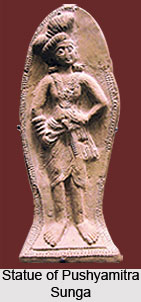 Pushyamitra Sunga or Pushpatmitra reigned from 185 BC to 151 BC. Pushyamitra Sunga was originally the General and commander-in-chief or the Senapati of the Mauryan army. He assassinated the last Mauryan emperor Brhadratha in 185 BC and himself became the king with the initialization of Sunga dynasty in Indian history. Pushyamitra Sunga then performed the Ashwamedha Yajna or the horse sacrifice following the tradition of the ancient kings. He brought whole northern India under his rule. His kingdom was spread as far as Jalandhar in Punjab as inscriptions of the Sungas have been found from Jalandhar. The Divyavadana stated that his rule extended as far as Sagala or Sialkot.
Pushyamitra Sunga or Pushpatmitra reigned from 185 BC to 151 BC. Pushyamitra Sunga was originally the General and commander-in-chief or the Senapati of the Mauryan army. He assassinated the last Mauryan emperor Brhadratha in 185 BC and himself became the king with the initialization of Sunga dynasty in Indian history. Pushyamitra Sunga then performed the Ashwamedha Yajna or the horse sacrifice following the tradition of the ancient kings. He brought whole northern India under his rule. His kingdom was spread as far as Jalandhar in Punjab as inscriptions of the Sungas have been found from Jalandhar. The Divyavadana stated that his rule extended as far as Sagala or Sialkot.
Pushyamitra Sunga was the follower of Hindu tradition and hostile towards Buddhists and had oppressed Buddhist faith. A Buddhist tradition considered Pushyamitra as the person who had taken measures to stop the spread of Buddhism as "the number one enemy of the sons of Shakyas and the cruelest prosecutor of the religion." In Divyavadana it is mentioned that Pushyamitra Sunga destroyed many Buddhist stupas and viharas built by Emperor Ashoka. He had a tendency to demolish the works of Ashoka.
Some historians reject the possibility of Pushyamitra Sunga`s being anti-Buddhist. The narrations of Ashokavadana and Divyavadana are said to be exaggerated. The Ashokavadana legend more likely describes Pusyamitra`s attack on Maurya dynasty and thereby depicting him as an enemy of Buddhism, who had reduced Buddhist influence on his imperial court.
Historical evidences show that Buddhist faith was supported by Pushyamitra Sunga as is found from an epigraph on the gateway of Bharhut which was erected during the supremacy of the Sungas. Sir John Marshall suggested that Sanchi Stupa was vandalized by Pushyamitra Sunga before it`s rebuilt by his successor Agnimitra. Similarly, the Deokothar Stupa located between Sanchi and Bharhut was demolished during the same period. But archaeological evidences are always very uncertain.
The reign of Pushyamitra witnessed much warfare, which was characteristic feature of that era. Pushyamitra had fight with the Andhras, Kalingas and Indo Greeks and probably by kingdoms of Panchala and Mathura. After killing Brhadratha during an army review, Pushyamitra Sunga prevented the advance of Bactrian Greeks.
The Greek rulers of Greco-Bactrian Kingdom attacked northwestern India during 180 BC and subsequently conquered most of the Punjab. They had ruled in Mathura for sometime and might have campaigned towards east as far as Pataliputra. However, Pusyamitra`s army had repelled Indo Greeks. Mathura was taken from the Greeks and was ruled by the Sungas towards the end of the second century BC. Pushyamitra Sunga died in 151 BC and his son Agnimitra ascended the throne.



















